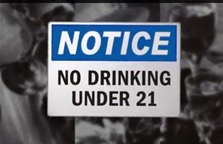Key points
- The minimum legal drinking age (MLDA) in the United States is 21 years.
- MLDA laws save lives and protect everyone, especially young people, from alcohol-related harm.

Minimum legal drinking age laws
- Minimum legal drinking age (MLDA) laws set the legal age when people can buy alcohol.
- The MLDA in the United States is 21 years. This means that alcohol cannot be sold to people younger than 21.
- Before the National Minimum Drinking Age Act of 1984, the MLDA could differ by state.
Health impacts
- About 4,000 people under the age of 21 die in the United States every year from excessive drinking—either directly or indirectly.1
- These deaths among young people happen, in part, because of underage drinking and its direct health effects.
- Such deaths also happen indirectly, such as from alcohol-related motor vehicle crashes and other injuries caused by others (aged 21 and older) who drink excessively.
- These deaths among young people happen, in part, because of underage drinking and its direct health effects.
Setting the legal age to 21 for buying alcohol has helped protect health by:
- Reducing motor vehicle crashes.
- Reducing underage drinking.
- Improving individual and community health.
Fewer motor vehicle crashes
Before the national law was in place, states that raised their MLDA to 21 years had a 16% drop in motor vehicle crashes.2
Less underage drinking
After states raised their MLDA to 21 years in 1984, the percentage of people who drank before turning 21 went down.
- From 1985 to 1991, the percentage of young people (aged 18 to 20) who reported drinking alcohol during the past month dropped almost 20%—from 59% to 40%.A3
Young adults also drank less alcohol when states raised their MLDA.
- From 1985 to 1991, the percentage of young people (aged 21 to 25) who reported drinking during the past month dropped almost 15%— from 70% to 56%.A3
Safer, healthier people and communities
The MLDA of 21 years helps lower the risk of developing alcohol and other substance use disorders, for those who drink alcohol. It also supports families and communities by leading to fewer harmful births, lower rates of suicide and homicide, and fewer deaths from alcohol poisoning.
- Data were not for the entire United States. In the report, data were analyzed from the 19 states that participated in the Behavioral Risk Factor Surveillance System from 1985 to 1999.
- Centers for Disease Control and Prevention. Alcohol-Related Disease Impact application. Accessed February 29, 2024. www.cdc.gov/ardi
- Shults RA, Elder RW, Sleet DA, et al. Reviews of evidence regarding interventions to reduce alcohol-impaired driving. Am J Prev Med. 2001;21(4 Suppl):66–88. doi: 10.1016/s0749-3797(01)00381-6
- Serdula MK, Brewer RD, Gillespie C, Denny CH, Mokdad A. Trends in alcohol use and binge drinking, 1985-1999: results of a multi-state survey. Am J Prev Med. 2004;26(4):294–298. doi: 10.1016/j.amepre.2003.12.017
- Community Preventive Services Task Force. Motor vehicle injury alcohol-impaired driving: maintaining current minimum legal drinking age (MLDA) laws. November 4, 2018. Accessed February 28, 2024.
- Mothers Against Drunk Driving (MADD). Why 21? Accessed November 29, 2023.
